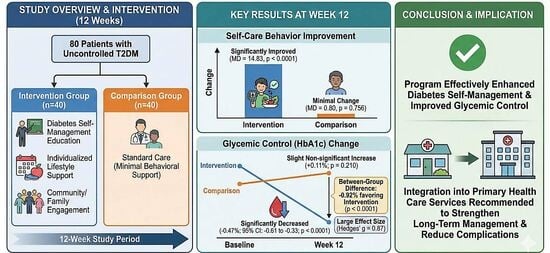Journal Description
Diabetology
Diabetology
is an international, peer-reviewed, open access journal on diabetes research published monthly online by MDPI.
- Open Access— free for readers, with article processing charges (APC) paid by authors or their institutions.
- High Visibility: indexed within ESCI (Web of Science), Scopus, EBSCO, and other databases.
- Rapid Publication: manuscripts are peer-reviewed and a first decision is provided to authors approximately 24.4 days after submission; acceptance to publication is undertaken in 8.9 days (median values for papers published in this journal in the second half of 2025).
- Journal Rank: CiteScore - Q2 (Medicine (miscellaneous))
- Recognition of Reviewers: APC discount vouchers, optional signed peer review, and reviewer names published annually in the journal.
Impact Factor:
2.2 (2024);
5-Year Impact Factor:
2.5 (2024)
Latest Articles
Aerobic Training Modulates the Expression of Components of the mPTP Through the Reduction of Oxidative Stress in the Soleus Muscle of Streptozotocin-Induced Diabetic Rats
Diabetology 2026, 7(1), 18; https://doi.org/10.3390/diabetology7010018 - 9 Jan 2026
Abstract
Background/Objectives: In all types of diabetes, elevated blood glucose levels cause pathological changes in skeletal muscle, primarily due to oxidative stress, mitochondrial dysfunction, and excessive production of reactive oxygen species (ROS). Regular exercise can help mitigate these effects; however, the underlying mechanisms, particularly
[...] Read more.
Background/Objectives: In all types of diabetes, elevated blood glucose levels cause pathological changes in skeletal muscle, primarily due to oxidative stress, mitochondrial dysfunction, and excessive production of reactive oxygen species (ROS). Regular exercise can help mitigate these effects; however, the underlying mechanisms, particularly those involving the mitochondrial permeability transition pore (mPTP), remain incompletely understood. This study aimed to explore the effects of aerobic exercise training (AET) on oxidative stress and the expression of mPTP components in the skeletal muscle of streptozotocin-induced diabetic rats. Methods: Male Wistar rats were randomly divided into three groups: Healthy Sedentary (H-SED), Diabetic Sedentary (D-SED), and Diabetic Exercise-trained (D-EXER); n = 6 per group. The D-EXER group performed AET (0° slope) 5 days/week for 8 weeks. After the intervention period, body weight and fasting blood glucose (FBG) levels were measured, and soleus muscles were collected and analyzed for oxidative stress biomarkers, Western blotting, and gene expression using qRT-PCR. Results: Following an 8-week intervention, AET reduced FBG concentrations. Accordingly, in the soleus muscles of the D-EXER group, ROS levels decreased, and redox balance was improved compared to the D-SED group. Exercise training reduced CypD and Casp9 mRNA expression and increased Bcl-2 mRNA expression, whereas Ant1 mRNA expression was only slightly altered. CypD protein expression was decreased in exercised diabetic rats, while VDAC1 protein and mRNA levels remained unchanged. In the D-EXER group, there were significant inverse correlations between CypD and Casp9 mRNA expression levels and glutathione redox state. Conclusions: The current study suggests that 8 weeks of AET, in addition to reducing hyperglycemia, may favorably influence oxidative balance and the expression of mPTP-related molecular components in diabetic skeletal muscle.
Full article
(This article belongs to the Special Issue Exercise as Medicine: Exploring the Prevention and Management of Diabetes)
►
Show Figures
Open AccessArticle
Stakeholder Perspectives on Implementing DiabeText: Exploring Barriers and Facilitators for a Personalized Diabetes Self-Management SMS Intervention in Spain
by
Elena Gervilla-García, Patricia García-Pazo, Mireia Guillén-Solà, Federico Leguizamo, Ignacio Ricci-Cabello, María Jesús Serrano-Ripoll, Miquel Bennasar-Veny, Maria Antònia Fiol-deRoque, Escarlata Angullo-Martínez and Rocío Zamanillo-Campos
Diabetology 2026, 7(1), 17; https://doi.org/10.3390/diabetology7010017 - 8 Jan 2026
Abstract
►▼
Show Figures
Background/Objectives: Mobile health (mHealth) interventions can enhance chronic disease management, but their integration into public healthcare systems remains complex. DiabeText is the first SMS-based intervention in Spain delivering personalized diabetes self-management support using electronic health record data. This study explored perceived barriers and
[...] Read more.
Background/Objectives: Mobile health (mHealth) interventions can enhance chronic disease management, but their integration into public healthcare systems remains complex. DiabeText is the first SMS-based intervention in Spain delivering personalized diabetes self-management support using electronic health record data. This study explored perceived barriers and facilitators to the implementation of DiabeText in the Spanish public health context from the perspective of key stakeholders. Methods: A qualitative study was conducted using semi-structured interviews with 14 purposively selected stakeholders involved in digital health, diabetes care, data protection, and healthcare management across several Spanish regions. Interviews were thematically analyzed using Braun and Clarke’s approach and guided by the Implementation Research Logic Model. Results: Participants reported several barriers, including concerns regarding data protection, uncertainty about long-term sustainability, insufficient training and engagement of healthcare professionals and low digital literacy among certain patient groups. Facilitators included favorable institutional momentum for digital innovation, funding availability, perceived clinical utility and scalability of DiabeText, and growing patient familiarity with digital tools. Recommended strategies included integration into existing healthcare systems and workflows, professional training and use of familiar communication platforms. Conclusions: Effective implementation of DiabeText requires addressing regulatory, organizational, and equity-related barriers while leveraging institutional support and readiness for innovation. Early involvement of healthcare professionals, robust data governance, and investment in digital literacy are essential to ensure sustainable and equitable adoption. These findings provide actionable insights to support the integration of mHealth tools into chronic disease care in Spain and similar settings.
Full article

Figure 1
Open AccessArticle
Purpose in Life and Insulin Resistance in a Large Occupational Cohort: Cross-Sectional Associations Using TyG, SPISE-IR, and METS-IR Indices
by
Pilar García Pertegaz, Pedro Juan Tárraga López, Irene Coll Campayo, Carla Busquets-Cortés, Ángel Arturo López-González and José Ignacio Ramírez-Manent
Diabetology 2026, 7(1), 16; https://doi.org/10.3390/diabetology7010016 - 7 Jan 2026
Abstract
►▼
Show Figures
Background: Insulin resistance (IR) is a key metabolic abnormality underlying type 2 diabetes and cardiometabolic diseases. Although lifestyle and sociodemographic determinants are well described, the role of psychosocial constructs—such as purpose in life—remains insufficiently characterized. No prior study in large occupational samples
[...] Read more.
Background: Insulin resistance (IR) is a key metabolic abnormality underlying type 2 diabetes and cardiometabolic diseases. Although lifestyle and sociodemographic determinants are well described, the role of psychosocial constructs—such as purpose in life—remains insufficiently characterized. No prior study in large occupational samples has examined the associations between purpose in life and IR when evaluated through three complementary indices: the triglyceride–glucose index (TyG), the Single-Point Insulin Sensitivity Estimator for Insulin Resistance (SPISE-IR), and the metabolic score for insulin resistance (METS-IR). Objectives: To analyze the cross-sectional associations between purpose in life and IR indicators in a large working population and determine whether these associations persist after accounting for sociodemographic and lifestyle factors. Methods: A cross-sectional study was conducted among 93,077 Spanish workers aged 20–69 years undergoing routine occupational health examinations. IR was estimated using TyG, SPISE-IR, and METS-IR indices. Purpose in life was assessed using the 10-item Purpose in Life Test and categorized into three groups based on the empirical distribution of scores. Multinomial logistic regression models adjusted for age, sex, social class, smoking, Mediterranean diet adherence, physical activity, and BMI were used to examine associations. Results: Lower purpose in life was consistently associated with higher IR categories across all indices. Compared with individuals reporting high purpose, those with low purpose had higher odds of belonging to the high IR category (TyG ORa 1.59; 95% CI 1.45–1.74; SPISE-IR ORa 1.94; 95% CI 1.76–2.13; METS-IR ORa 2.21; 95% CI 1.98–2.47). Adding purpose in life to sociodemographic and lifestyle models modestly improved discrimination for identifying high IR categories. Conclusions: In this large occupational cohort, purpose in life was independently associated with insulin resistance as measured by three metabolic indices. These findings highlight the relevance of psychosocial factors in metabolic health. Longitudinal studies are needed to clarify temporal pathways and assess whether purpose-oriented approaches may contribute to improved metabolic profiles.
Full article

Figure 1
Open AccessArticle
Influence of Internet Use on Welcome to Medicare or Annual Wellness Visit Utilization Among Medicare Beneficiaries with Type 2 Diabetes: A Cross-Sectional Analysis
by
Jaeyi Hahn, Morgan P. Stewart, Samuel D. C. Towne, Jr., YunYing Zhong, Nicholas Sherwin and Boon Peng Ng
Diabetology 2026, 7(1), 15; https://doi.org/10.3390/diabetology7010015 - 7 Jan 2026
Abstract
Background/Objectives: The increasing availability of online health information underscores the importance of digital resources and internet use, especially for older adults. Despite the benefits, utilization of Welcome to Medicare (WTM) and Annual Wellness Visits (AWV) remains suboptimal, particularly for those with diabetes.
[...] Read more.
Background/Objectives: The increasing availability of online health information underscores the importance of digital resources and internet use, especially for older adults. Despite the benefits, utilization of Welcome to Medicare (WTM) and Annual Wellness Visits (AWV) remains suboptimal, particularly for those with diabetes. This study examined the relationship between internet use and WTM/AWV utilization among Medicare beneficiaries with diabetes. Methods: The 2021 Medicare Current Beneficiary Survey was analyzed, which is a nationally representative survey of Medicare beneficiaries aged ≥65 years with self-reported type 2 diabetes (n = 1444). The binary dependent variable was self-reported WTM/AWV utilization. The 3 binary independent variables were whether beneficiaries used the internet to (1) look up health information; (2) schedule an appointment with healthcare provider; and (3) communicate with healthcare provider. A survey-weighted logistic regression model was used to examine their associations, adjusted for socio-demographics and comorbidities. Results: Of study beneficiaries, 57.5% reported WTM/AWV utilization. Among WTM/AWV users and non-users, 56.1% and 42.5%, respectively, looked up health information online. Additionally, among WTM/AWV users and non-users, 31.6% and 26.1%, respectively, scheduled appointments online, and 39.8% and 34.3%, respectively, communicated with providers online. Adjusted analysis found that looking up health information online was associated with higher odds of WTM/AWV utilization (OR: 1.76, 95% CI: 1.36–2.28), while the other internet use behaviors were not statistically significant. Conclusions: Approximately 40% of study beneficiaries did not report using WTM/AWV. Improving internet use for health information and digital literacy among at-risk Medicare beneficiaries with diabetes may have a positive influence on WTM/AWV utilization and may support broader use of digital tools in diabetes care.
Full article
Open AccessArticle
Effectiveness of a Community-Based Health Care Program on Glycemic Control Among Patients with Uncontrolled Type 2 Diabetes Mellitus: A Quasi-Experimental Study
by
Patcharin Phuwilert, Supatra Noo-In, Chitkamon Srichomphoo, Jirarat Ruetrakul, Ruchakron Kongmant and Santisith Khiewkhern
Diabetology 2026, 7(1), 14; https://doi.org/10.3390/diabetology7010014 - 6 Jan 2026
Abstract
Background: Type 2 diabetes mellitus (T2DM) is a major public health problem in Thailand, particularly in rural areas where individuals have limited access to structured diabetes care and education. Poor self-management contributes to uncontrolled glycemic levels and long-term complications. Objectives: This
[...] Read more.
Background: Type 2 diabetes mellitus (T2DM) is a major public health problem in Thailand, particularly in rural areas where individuals have limited access to structured diabetes care and education. Poor self-management contributes to uncontrolled glycemic levels and long-term complications. Objectives: This study evaluated the effectiveness of a community-based health care program on glycemic control and self-care behaviors among adults with uncontrolled T2DM. Methods: A quasi-experimental study was conducted among 80 patients with uncontrolled T2DM in Kalasin Province. Participants were assigned to either an intervention group (n = 40) or a comparison group (n = 40). The 12-week intervention consisted of diabetes self-management education, individualized lifestyle support, and community/family engagement. Diabetes self-care behavior and glycated hemoglobin (HbA1c) were assessed at baseline and Week 12. Statistical analyses included paired t-test, independent t-test, and 95% confidence intervals. Results: The intervention group demonstrated a significant improvement in self-care behavior (MD = 14.83; p < 0.0001), compared with a minimal change in the comparison group (0.80; p = 0.756). HbA1c levels significantly decreased in the intervention group (−0.47%; 95% CI: −0.61 to −0.33; p < 0.0001), while a slight nonsignificant increase was observed in the comparison group (0.11%; p = 0.210). The between-group analysis showed a significant reduction in HbA1c favoring the intervention (−0.92%; p < 0.0001), supported by a large effect size (Hedges’ g = 0.87). Conclusions: This community-based health care program effectively enhanced diabetes self-management behaviors and improved glycemic control. Integrating such behavioral support into primary health care services may strengthen long-term diabetes management and reduce complications among patients with uncontrolled T2DM.
Full article
(This article belongs to the Special Issue Advances in Diabetes: Prevalence, Risk Factors, Complications, Costs and Disparities)
►▼
Show Figures

Graphical abstract
Open AccessArticle
Inflammatory Markers Among African American Adolescents with Type 2 Diabetes Mellitus and Obesity: A Cross-Sectional Study
by
Christy Foster, Nekayla Anderson, Ivree Datcher, Ambika Ashraf and Bertha Hidalgo
Diabetology 2026, 7(1), 13; https://doi.org/10.3390/diabetology7010013 - 6 Jan 2026
Abstract
Background/Objectives: Type 2 diabetes (T2D), a chronic metabolic disorder characterized by systemic inflammation, disproportionately affects African American adolescents. Metformin may reduce inflammation beyond glycemic control; however, its impact on inflammatory markers in adolescents remains unclear. We hypothesized that inflammatory markers would differ across
[...] Read more.
Background/Objectives: Type 2 diabetes (T2D), a chronic metabolic disorder characterized by systemic inflammation, disproportionately affects African American adolescents. Metformin may reduce inflammation beyond glycemic control; however, its impact on inflammatory markers in adolescents remains unclear. We hypothesized that inflammatory markers would differ across groups defined by diabetes, obesity, and metformin use. Methods: In this cross-sectional analysis, inflammatory markers (C-reactive protein [CRP], interleukin-6 [IL-6], and tumor necrosis factor-alpha [TNF-α]), metabolic panels, and metformin exposure were assessed in African American adolescents from Children’s of Alabama. Simple and multivariate linear regression models were used to test associations between metformin use and inflammatory markers, adjusting for age, sex, and BMI z-score. Results: Among 78 adolescents, metformin use was reported in 73.6% of those with T2D + obesity and 27.3% of those with obesity-only. In the T2D + obesity group, metformin use was associated with TNF-α (β = 0.34, p = 0.02). Conclusions: Metformin use was associated with higher levels of specific inflammatory markers, potentially reflecting that metformin was more likely utilized in more severe diseases. Longitudinal studies are needed to disentangle treatment effects from underlying disease progression.
Full article
Open AccessArticle
Ethnic Inequities in Achieving Glycaemic and Other Clinical Targets in Type 2 Diabetes
by
Sara Mustafa, Mark Rodrigues, Le Tuan Anh Nguyen, Tim Kenealy, Rawiri Keenan, Barbara de Graaff, Ryan Paul and Lynne Chepulis
Diabetology 2026, 7(1), 12; https://doi.org/10.3390/diabetology7010012 - 5 Jan 2026
Abstract
Background/Objectives: Ethnic disparities in type 2 diabetes (T2D) outcomes remain a significant public health challenge in Aotearoa New Zealand (NZ), but are not accurately reported in large datasets. This cross-sectional study used linked regional health records to examine ethnic inequities in glycaemic control
[...] Read more.
Background/Objectives: Ethnic disparities in type 2 diabetes (T2D) outcomes remain a significant public health challenge in Aotearoa New Zealand (NZ), but are not accurately reported in large datasets. This cross-sectional study used linked regional health records to examine ethnic inequities in glycaemic control and achievement of clinical targets among adults with T2D in the Waikato and Auckland regions. Methods: A cross-sectional analysis was conducted on 57,734 adults aged 18–75 years with confirmed T2D enrolled in four Primary Healthcare Organisations. Clinical and sociodemographic data from February 2021 to December 2023 were linked via National Health Index numbers. Key outcomes included the percentage of patients at target for HbA1c, blood pressure, lipid profiles, renal and liver function tests. Logistic regression assessed associations between ethnicity, socioeconomic deprivation, and clinical target attainment. Results: The mean age was 56.5 ± 12.4 years, and 86.8% of the cohort were overweight or obese. Overall, only 46.3% achieved the HbA1c target (<53 mmol/mol) in their most recent test, with Māori (OR 1.35) and Pacific (OR 1.84) ethnicities, higher deprivation, obesity, and younger age independently associated with elevated HbA1c. Hypertension affected two-thirds of participants (71.9% above target), notably Asians and Pacific peoples. Māori and Pacific peoples had over twice the odds of renal impairment and were 2.5 times more likely to have elevated albumin-to-creatinine ratios. Abnormal liver function test decreased with age (OR ≤ 0.65), though Asians had over twice the odds of elevated ALT and AST compared to Europeans. Conclusions: Significant ethnic inequities exist in glycaemic and clinical target attainment among people with T2D in NZ. These findings highlight critical gaps in diabetes management and underscore the urgent need for targeted, equity-focused interventions addressing both socioeconomic and ethnic disparities to improve outcomes and reduce health inequities.
Full article
Open AccessArticle
The Role of the Neutrophil-to-Lymphocyte Ratio in Patients with Diabetes and Atrial Fibrillation: Insights from the National Spanish Registry Sumamos-FA-SEMI
by
José Carlos Arévalo-Lorido, Juana Carretero-Gómez, Alberto Muela Molinero, Esther Montero-Hernández, Juan Bosco López-Sáez, Maria Isabel González-Anglada, Miguel Angel Vazquez-Ronda, Jesús Castiella-Herrero, José Pablo Miramontes-González, Rocío García-Alonso and on behalf of Sumamos-FA-SEMI Registry
Diabetology 2026, 7(1), 11; https://doi.org/10.3390/diabetology7010011 - 5 Jan 2026
Abstract
►▼
Show Figures
Aim: To analyse the importance of inflammation in the disease burden and prognosis of patients with type 2 diabetes (T2DM) and atrial fibrillation (AF). We assessed these patients according to their neutrophil-to-lymphocyte ratio (NLR) values, examining their baseline characteristics and their prognosis at
[...] Read more.
Aim: To analyse the importance of inflammation in the disease burden and prognosis of patients with type 2 diabetes (T2DM) and atrial fibrillation (AF). We assessed these patients according to their neutrophil-to-lymphocyte ratio (NLR) values, examining their baseline characteristics and their prognosis at one year of follow-up based on a prospective AF registry in Spain (Sumamos-FA-SEMI). Methods: A prospective, multicentre, observational study of patients with AF (Sumamos-FA-SEMI) was conducted. We categorised the patients into four groups according to the presence of T2DM and NLR levels with a reference cut-off point of three. We compared the characteristics of the four groups and evaluated the prognosis using the mean values of all-cause mortality and all-cause mortality plus readmissions during a year of follow-up. Results: We analysed 1071 patients, 482 of whom had T2DM. This group had significantly higher rates of obesity and comorbidities. Groups with an NLR greater than three points had a higher prevalence of cancer, lower HDL cholesterol levels, and more albuminuria. Other inflammatory markers, such as C-reactive protein, were also higher in these groups. Regarding prognosis, groups (both with and without T2DM) with an NLR greater than three had significantly higher mortality, with a higher probability in those without T2DM (HR 3.58, 95% CI: 1.99–6.43, p < 0.00). In terms of mortality and readmissions, only the group without T2DM and with an NLR greater than three had significantly higher mortality (HR 2.19, 95% CI: 1.51–3.19, p < 0.00). Conclusions: Among atrial fibrillation patients, the combination of T2DM and high inflammation (NLR) was linked to higher comorbidity, worse metabolic and kidney disease, and the poorest prognosis. Surprisingly, the highest risk of readmission or death was in non-T2DM patients with higher NLR levels, suggesting that T2DM treatments may mitigate risk.
Full article

Figure 1
Open AccessArticle
Leveraging the Individualized Metabolic Surgery Score to Predict Weight Loss with Tirzepatide in Adults with Type 2 Diabetes and Obesity
by
Regina Castaneda, Diego Sepulveda, Rene Rivera Gutierrez, Jose Villamarin, Dima Bechenati, Maria A. Espinosa, Alfredo Verastegui, Elif Tama, Allyson W. McNally, Pamela K. Bennett, Andres Acosta and Maria D. Hurtado Andrade
Diabetology 2026, 7(1), 10; https://doi.org/10.3390/diabetology7010010 - 5 Jan 2026
Abstract
►▼
Show Figures
Background/Objectives: Individuals with type 2 diabetes (T2D) achieve less total body weight loss (TBWL) with obesity medications compared to those without T2D. The individualized metabolic surgery (IMS) score, originally developed to predict T2D remission after bariatric surgery, inversely correlates with TBWL response to
[...] Read more.
Background/Objectives: Individuals with type 2 diabetes (T2D) achieve less total body weight loss (TBWL) with obesity medications compared to those without T2D. The individualized metabolic surgery (IMS) score, originally developed to predict T2D remission after bariatric surgery, inversely correlates with TBWL response to semaglutide. IMS reflects T2D severity, incorporating HbA1c and T2D duration and medication use. This study aims to evaluate TBWL with tirzepatide across IMS severity categories and identify predictors of response in a real-world cohort. Methods: This retrospective analysis included 717 adults with T2D using tirzepatide for overweight or obesity within the Mayo Clinic Health System. Patients were stratified by IMS severity (mild, moderate, severe) and quartiles. Primary endpoint: TBWL% at 15 months. Secondary endpoints: categorical thresholds (≥5%, ≥10%, ≥15%, ≥20%) and predictors of TBWL%. Linear mixed-effects models and regression models were employed. Results: At 15 months, TBWL was greater in mild versus severe IMS groups (14.8% vs. 11.0%, p = 0.015), with similar trends across quartiles. The proportion achieving ≥ 20% TBWL was nearly two-fold higher in mild versus severe IMS (27% vs. 14%, p = 0.03). Female sex independently predicted greater TBWL, whereas insulin use, higher T2D medication burden (particularly weight-promoting agents), and HbA1c > 7% were associated with less TBWL. Conclusions: Tirzepatide produced clinically meaningful TBWL across all IMS categories, although TBWL declined with increasing IMS severity. Glycemic control and T2D medication use emerged as strong predictors of TBWL. The IMS score may serve as a practical tool to anticipate weight-loss trajectories, guide personalized treatment decisions, and inform patient counseling.
Full article

Figure 1
Open AccessProtocol
Preventing Indigenous Cardiovascular Disease and Diabetes Through Exercise (PrIDE) Study Protocol: A Co-Designed Wearable-Based Exercise Intervention with Indigenous Peoples in Australia
by
Morwenna Kirwan, Connie Henson, Blade Bancroft-Duroux, David Meharg, Vita Christie, Amanda Capes-Davis, Sara Boney, Belinda Tully, Debbie McCowen, Katrina Ward, Neale Cohen and Kylie Gwynne
Diabetology 2026, 7(1), 9; https://doi.org/10.3390/diabetology7010009 - 4 Jan 2026
Abstract
Chronic diseases disproportionately impact Indigenous peoples in Australia, with type 2 diabetes mellitus (T2DM) and cardiovascular disease (CVD) representing leading causes of morbidity and mortality. Despite evidence supporting community-based exercise interventions for T2DM management, no culturally adapted programs utilizing wearable technology have been
[...] Read more.
Chronic diseases disproportionately impact Indigenous peoples in Australia, with type 2 diabetes mellitus (T2DM) and cardiovascular disease (CVD) representing leading causes of morbidity and mortality. Despite evidence supporting community-based exercise interventions for T2DM management, no culturally adapted programs utilizing wearable technology have been co-designed specifically with Indigenous Australian communities. This study protocol aims to determine if wearable-based exercise interventions can effectively prevent CVD development and manage T2DM progression in Indigenous Australians through culturally safe, community-led approaches. The PrIDE study protocol describes a mixed-methods translational research design incorporating Indigenous and Western methodologies across three phases: (1) co-designing culturally adapted exercise programs and assessment tools, (2) implementing interventions with wearable monitoring, and (3) conducting evaluation and scale-up assessment. Sixty-four Indigenous Australian adults with T2DM will be recruited across remote, rural/regional sites to self-select into either individual or group exercise programs using the Withings ScanWatch 2. Primary outcomes include cardiovascular risk factors, physical fitness, and health self-efficacy measured using culturally adapted tools. Indigenous governance structures will ensure cultural safety and community ownership throughout. The PrIDE protocol presents a novel approach to improving health equity while advancing understanding of wearable technology integration in Indigenous healthcare, informing future larger-scale trials and policy development.
Full article
(This article belongs to the Special Issue Exercise as Medicine: Exploring the Prevention and Management of Diabetes)
►▼
Show Figures

Graphical abstract
Open AccessArticle
Distribution of ApoE Gene Polymorphism and Its Association with the Lipid Profile Among Type 2 Diabetes Mellitus Black South Africans
by
Siphesihle Mkhwanazi, Tumelo Jessica Mapheto, Honey Bridget Mkhondo, Olebogeng Harold Majane, Sechene Stanley Gololo and Mashudu Nemukula
Diabetology 2026, 7(1), 8; https://doi.org/10.3390/diabetology7010008 - 4 Jan 2026
Abstract
►▼
Show Figures
Background: ApoE is a major regulator of lipid metabolism and glycaemic control. The aim of the current study is to investigate the ApoE gene polymorphisms among Black South Africans with and without type 2 diabetes mellitus (T2DM) and associate them with their
[...] Read more.
Background: ApoE is a major regulator of lipid metabolism and glycaemic control. The aim of the current study is to investigate the ApoE gene polymorphisms among Black South Africans with and without type 2 diabetes mellitus (T2DM) and associate them with their lipid profile. Methods: A cross-sectional case–control study was conducted among 107 participants, divided into two groups: patients with T2DM (n = 65) and non-diabetic controls (n = 42). Blood samples were collected for analysis of glycated haemoglobin, lipid profile, nitric oxide, high-sensitivity C-reactive protein and DNA genotyping using the MALDI-TOF. Continuous variables were analysed using Student’s t-test or one-way analysis of variance (ANOVA). Genotype and allele frequencies were compared using Fisher’s exact tests. Results: The ApoE3 allele was the most prevalent among both groups, observed in 55.47% in T2DM patients and 52.38% in the non-diabetic group, followed by E4 and E2. HWE analysis revealed a deviation from equilibrium [χ2 (3) = 9.137, p = 0.0275]. TG levels differed significantly across ApoE alleles (F = 3.68, p = 0.03), with higher TG concentrations observed among E3 allele carriers and E4 allele carriers. Poor glycaemic control (HbA1c ≥ 7.0%) predominated across all ApoE alleles. Among E3 allele carriers, 75.0% of participants exhibited poor glycaemic control, whereas only 25.0% achieved good glycaemic control (p = 0.002). Conclusions: ApoE polymorphisms are associated with allele-specific heterogeneity in lipid metabolism and glycaemic control among individuals with T2DM, underscoring the complex, context-dependent role of genetic variation in metabolic dysregulation within African populations.
Full article

Figure 1
Open AccessReview
SLC35 Transporters: The Missing Link Between Glycosylation and Type 2 Diabetes
by
Xu Zhang, Hafiza Mahreen Mehwish and Pulin Che
Diabetology 2026, 7(1), 7; https://doi.org/10.3390/diabetology7010007 - 1 Jan 2026
Abstract
Type 2 diabetes mellitus (T2D) affects hundreds of millions worldwide, with recent estimates indicating approximately 589 million adults living with diabetes, most with type 2 disease. Beyond classical insulin signaling pathways, increasing evidence implicates altered protein glycosylation in metabolic dysfunction. The solute carrier
[...] Read more.
Type 2 diabetes mellitus (T2D) affects hundreds of millions worldwide, with recent estimates indicating approximately 589 million adults living with diabetes, most with type 2 disease. Beyond classical insulin signaling pathways, increasing evidence implicates altered protein glycosylation in metabolic dysfunction. The solute carrier 35 (SLC35) family of nucleotide sugar transporters mediates the import of activated sugars into the endoplasmic reticulum and Golgi lumen, thereby influencing global glycosylation patterns. Dysregulation of these transporters can perturb glucose homeostasis, insulin responsiveness, and nutrient-sensing pathways through changes in glycosylation flux. In this review, we dissect the molecular mechanisms by which these transporters modulate glucose homeostasis, insulin signaling pathways, protein O-GlcN acylation, and broader glycosylation processes. We integrate findings from human genetic studies, rodent models, and in vitro functional analyses to characterize how altered SLC35 activity is associated with T2D and metabolic syndrome. Four members demonstrate particularly compelling evidence: SLC35B4 modulates hepatic glucose metabolism, SLC35D3 mutations impair dopaminergic signaling and energy balance, and SLC35F3 variants interact with high-carbohydrate intake to increase metabolic-syndrome risk. SLC35A3, though less studied, may influence glycosylation-dependent insulin signaling through its role in N-glycan biosynthesis. Beyond these characterized transporters, this review identifies potential metabolic roles for understudied family members, suggesting broader implications across the entire SLC35 family. We also discuss how such alterations can lead to disrupted hexosamine flux, impaired glycoprotein processing, aberrant cellular signaling, and micronutrient imbalances. Finally, we evaluate the therapeutic potential of targeting SLC35 transporters, outlining both opportunities and challenges in translating these insights into novel T2D treatments.
Full article
(This article belongs to the Special Issue New Perspectives on Diabetes and Stroke Research)
►▼
Show Figures

Figure 1
Open AccessReview
The Evolving Role of Continuous Glucose Monitoring in Hospital Settings: Bridging the Analytical and Clinical Needs
by
Špela Volčanšek, Andrej Janež and Matevž Srpčič
Diabetology 2026, 7(1), 6; https://doi.org/10.3390/diabetology7010006 - 1 Jan 2026
Abstract
►▼
Show Figures
Background: The use of continuous glucose monitoring (CGM) offers several benefits. Compared to point-of-care (POC) capillary glucose tests, user acceptability is greater, and time in the target glucose range is improved. If these advantages can be transferred from outpatient to in-patient settings,
[...] Read more.
Background: The use of continuous glucose monitoring (CGM) offers several benefits. Compared to point-of-care (POC) capillary glucose tests, user acceptability is greater, and time in the target glucose range is improved. If these advantages can be transferred from outpatient to in-patient settings, CGM could assist clinicians in making timely, proactive treatment decisions. Scope of the review: This scoping review focuses on clinical studies of CGM use in hospital settings among non-pregnant adults, with a particular focus on studies from 2023 to 2025. It examines the latest evidence and guidelines and sets out the clinical and analytical considerations involved in implementing in-patient CGM. Main findings: In-hospital CGM facilitates hypoglycemia detection, especially asymptomatic and nocturnal episodes. Data on the impact of CGM use on clinical outcomes are scarce, and most studies focus on the reliability of CGM technology rather than clinical outcomes. Several factors affect CGM accuracy in hospitals, such as medications, fluid management, and hemodynamic disturbances. Despite between-device and settings-related variability, CGM devices generally show reasonable accuracy, with Mean Absolute Relative Differences (MARDs) ranging from 10% to 23%. In-hospital CGM has also improved workflows and reduced personnel exposure in infectious disease settings. Key implementation challenges: The MARD thresholds for safe in-hospital CGM use without confirmatory POC testing and evidence-based protocols for CGM application in ICU and non-ICU settings are not yet established. Despite challenges related to implementation, including personnel training, integrating diabetes technology with electronic health records, and costs, the benefits of improved monitoring and in-patient safety make CGM use worthwhile to pursue.
Full article

Graphical abstract
Open AccessArticle
Extracellular Matrix—Key to Maintaining Function of Encapsulated Human Stem Cell Differentiated Islet Clusters Seeded into Scaffolds as a Diabetes Therapy
by
Xu Bai, Hui Chen, Jon Odorico, Connie Chamberlain, Kfir Molakandov, Tim R. Dargaville, Michel Revel and Bernard E. Tuch
Diabetology 2026, 7(1), 5; https://doi.org/10.3390/diabetology7010005 - 1 Jan 2026
Abstract
►▼
Show Figures
Background/Objectives: A stem cell therapy for type 1 diabetes (T1D) is experimentally available but only to those few humans in whom the use of systemic immunosuppression can be justified. For others with T1D, a means to deliver the islets needs to be perfected.
[...] Read more.
Background/Objectives: A stem cell therapy for type 1 diabetes (T1D) is experimentally available but only to those few humans in whom the use of systemic immunosuppression can be justified. For others with T1D, a means to deliver the islets needs to be perfected. We have previously bioengineered a removable device for this purpose and now wish to test the effect of adding extracellular matrix (ECM) derived from decellularised human pancreas to it. Methods: The complete device consists of encapsulated pluripotent stem cell differentiated islets seeded into tubular scaffolds of polycaprolactone made by melt electrospin writing and to which ECM was added. The seeded device was implanted either subcutaneously (SC) or intraperitoneally (IP) into streptozotocin diabetic immunodeficient mice. The outcome over the next few months was compared with that achieved in diabetic mice implanted IP with encapsulated islets alone. Results: The device seeded with encapsulated islets but not containing ECM functioned less well than encapsulated islets implanted alone, with lower human C-peptide production. However, when ECM was added to the seeded device and whether implanted SC or IP, islets functioned as efficiently as those implanted without use of a scaffold. Conclusions: These data provide optimism for the use of seeded scaffolds in diabetic humans in whom a single scaffold seeded with multiple encapsulated islets can more readily be removed if needed for safety reasons than can multiple encapsulated islets not seeded into a scaffold.
Full article

Graphical abstract
Open AccessArticle
Diabetic Kidney Disease Phenotype and Other Determinants of Cardiovascular and Renal Outcomes in Type 2 Diabetes
by
Stefanie Marie Agius, Jessica Mangion and Stephen Fava
Diabetology 2026, 7(1), 4; https://doi.org/10.3390/diabetology7010004 - 1 Jan 2026
Abstract
►▼
Show Figures
Background and Hypothesis: Diabetic kidney disease (DKD) is one of the major risk factors for all-cause mortality and cardiovascular disease in patients with diabetes mellitus. Different phenotypes have been described. In view of their different pathophysiology, these subtypes may behave differently. Methods: In
[...] Read more.
Background and Hypothesis: Diabetic kidney disease (DKD) is one of the major risk factors for all-cause mortality and cardiovascular disease in patients with diabetes mellitus. Different phenotypes have been described. In view of their different pathophysiology, these subtypes may behave differently. Methods: In this retrospective study, patients with type 2 diabetes mellitus (T2DM) were followed up for a maximum of 10 years or until death, whichever came first. Subjects were categorized into four DKD phenotypes: no DKD (no albuminuria or decreased estimated glomerular filtration rate (eGFR)), albuminuria without decreased eGFR (DKD 1), decreased eGFR without albuminuria (DKD 2 or non-albuminuric DKD), and decreased eGFR with albuminuria (DKD 3). Data on laboratory results, hospitalization, and mortality were obtained through electronic patient records. Univariate analyses were performed and the variables that were significant were entered as covariates in multivariate logistic regression models to estimate the risks of death, hospitalization for CAD, HF, and CrVD, and CKD progression. Results: Among 778 patients, 53.3% had no DKD, 31.2% had DKD 1, 5.4% had DKD 2, and 10% had DKD 3. Patients with DKD 2 exhibited the highest odds of mortality compared to those with no DKD (odds ratio (OR) of 6.7 [95% CI 2.8–16.0], p < 0.001). Pairwise comparisons using the log-rank test showed a significant difference in mortality between DKD 1 and DKD 2 (p < 0.001) and DKD 1 and DKD 3 (p < 0.001). However, no statistically significant difference in mortality was found between DKD 2 and DKD 3. Additionally, the greater variability in HbA1c and higher neutrophil–lymphocyte ratio (NLR) independently predicted all-cause mortality as well as hospitalization for heart failure. Conclusions: This contemporary T2DM cohort demonstrated that the DKD phenotype, HbA1c variability, and elevated NLR are linked to increased mortality. These factors may improve existing risk stratification models by enabling better identification of high-risk DKD patients and guide more personalized management.
Full article

Figure 1
Open AccessReview
Diabetic Retinopathy and Other Microvascular Complications of Diabetes—A Review of Multi-Omics Research
by
Julia Grzybowska-Adamowicz and Agnieszka Zmysłowska
Diabetology 2026, 7(1), 3; https://doi.org/10.3390/diabetology7010003 - 31 Dec 2025
Abstract
Microvascular complications of diabetes include retinopathy (DR), diabetic kidney disease (DKD), and neuropathy (DN), which play a crucial role in diabetes management, as they significantly impair the functionality of the patient and remain major causes of morbidity despite advances in glycaemic control. The
[...] Read more.
Microvascular complications of diabetes include retinopathy (DR), diabetic kidney disease (DKD), and neuropathy (DN), which play a crucial role in diabetes management, as they significantly impair the functionality of the patient and remain major causes of morbidity despite advances in glycaemic control. The aim of this review was to summarize multi-omics findings in DR, DKD, and DN. Multi-omics studies consist of genomic, epigenomic, transcriptomic, proteomic, and metabolomic research. These studies provided comprehensive insights into the complex mechanisms underlying microvascular complications of diabetes, such as inflammation, angiogenesis, and apoptosis in the retina, kidneys, and nervous system. They also enabled the search for emerging diagnostic, prognostic, and therapeutic biomarkers. Moreover, changes in microRNA levels were found to differentiate patients with non-proliferative and proliferative DR. In addition, different proteins and metabolites concentrations were noticed in diabetes macular oedema and tractional retinal detachment—serious complications of DR. Specific molecular signatures, such as miR-146a and miR-27 dysregulation, changes in levels of HLA-DRA, AGER, and HSPA1A proteins, and alterations in tyrosine, alanine, 2,4-dihydroxybutanoic acid, ribonic acid, myoinositol, ribitol, 3,4-dihydroxybutanoic acid, valine, glycine, and 2-hydroxyisovaleric acid, were found to be characteristic for all microvascular complications of diabetes. In the future, more studies in multi-omics are expected to help improve precision medicine approaches to treating diabetes, allowing for personalized prediction, prevention, and treatment of microvascular complications.
Full article
(This article belongs to the Special Issue New Perspectives and Future Challenges in Diabetic Retinopathy)
►▼
Show Figures

Graphical abstract
Open AccessArticle
Towards Robust Risk-Based Screening of Early-Stage Diabetes: Machine Learning Models with Union Features Selection and External Validation
by
Pasa Sukson, Watcharaporn Cholamjiak, Nontawat Eiamniran and Mallika Khwanmuang
Diabetology 2026, 7(1), 2; https://doi.org/10.3390/diabetology7010002 - 26 Dec 2025
Abstract
►▼
Show Figures
Background/Objectives: Early-stage diabetes often presents with subtle symptoms, making timely screening challenging. This study aimed to develop an interpretable and robust machine learning framework for early-stage diabetes risk prediction using integrated statistical and machine learning–based feature selection, and to evaluate its generalizability using
[...] Read more.
Background/Objectives: Early-stage diabetes often presents with subtle symptoms, making timely screening challenging. This study aimed to develop an interpretable and robust machine learning framework for early-stage diabetes risk prediction using integrated statistical and machine learning–based feature selection, and to evaluate its generalizability using real-world hospital data. Methods: A Union Feature Selection approach was constructed by combining logistic regression significance testing with ReliefF and MRMR feature importance scores. Five machine learning models—Decision Tree, Naïve Bayes, SVM, KNN, and Neural Network—were trained on the UCI Early Stage Diabetes dataset (N = 520) under multiple feature-selection scenarios. External validation was performed using retrospective hospital records from the University of Phayao (N = 60). Model performance was assessed using accuracy, precision, recall, and F1-score. Results: The union feature-selection approach identified four core predictors—polyuria, polydipsia, gender, and irritability—with additional secondary features providing only marginal improvements. Among the evaluated models, Naïve Bayes demonstrated the most stable external performance, achieving 85% test accuracy, balanced precision, recall, and F1-score, along with a moderate AUC of 0.838, indicating reliable discriminative ability in real-world hospital data. In contrast, SVM, KNN, and Neural Network models, despite exhibiting very high internal validation performance (>96%) under optimally selected ML features, showed marked performance decline during external validation, highlighting their sensitivity to distributional shifts between public and clinical datasets. Conclusions: The combined statistical–ML feature selection method improved interpretability and stability in early-stage diabetes prediction. Naïve Bayes demonstrated the strongest generalizability and is well suited for real-world screening applications. The findings support the use of integrated feature selection to develop efficient and clinically relevant risk assessment tools.
Full article

Figure 1
Open AccessReview
Cognitive Function in Children with Type 1 Diabetes: A Narrative Review
by
Hussein Zaitoon, Maria S. Rayas and Jane L. Lynch
Diabetology 2026, 7(1), 1; https://doi.org/10.3390/diabetology7010001 - 25 Dec 2025
Abstract
►▼
Show Figures
Background/Objectives: Type 1 diabetes (T1D) is a common childhood condition with rising global incidence. Because early-onset T1D coincides with key periods of brain maturation, affected children may face neurocognitive risks. This review summarizes current evidence on the neurocognitive impact of pediatric T1D and
[...] Read more.
Background/Objectives: Type 1 diabetes (T1D) is a common childhood condition with rising global incidence. Because early-onset T1D coincides with key periods of brain maturation, affected children may face neurocognitive risks. This review summarizes current evidence on the neurocognitive impact of pediatric T1D and related clinical implications. Methods: A structured search of PubMed, Scopus, and Web of Science (inception–October 2025) used combinations of terms related to T1D, cognitive outcomes, and brain imaging. Studies involving participants under 18 years that reported cognitive or neuroimaging findings were included. Results: Diabetic ketoacidosis (DKA) at diagnosis is consistently linked with acute and longer-term neurological injury, including reduced brain volume and potential persistent deficits in memory and executive functioning. Severe or recurrent hypoglycemia disproportionately affects the hippocampus, contributing to lasting learning and memory impairments. Chronic hyperglycemia is a major driver of progressive neurocognitive decline; higher HbA1c is associated with smaller brain volumes and poorer executive function, attention, and processing speed. Early-onset disease and longer duration further increase vulnerability. These neurocognitive effects translate into modest reductions in academic performance and quality of life, especially with poor glycemic control. Emerging evidence suggests that continuous glucose monitoring, insulin pumps, and hybrid closed-loop systems improve metabolic stability and may support healthier brain development. Conclusions: T1D children experience subtle but meaningful neurocognitive risks shaped by glycemic extremes and early disease onset. Routine neuropsychological monitoring, strengthened academic support, and wider use of advanced diabetes technologies may help preserve cognitive development. Larger, longitudinal neuroimaging studies are needed to guide targeted neuroprotective strategies.
Full article

Graphical abstract
Open AccessArticle
Glucagon-like Peptide-1 Receptor Agonists and Survival in Advanced Chronic Kidney Disease and Type 2 Diabetes
by
Scott Reule, Sean Pickthorn, Stefanie Worwa, Areef Ishani and Robert Foley
Diabetology 2025, 6(12), 161; https://doi.org/10.3390/diabetology6120161 - 9 Dec 2025
Abstract
►▼
Show Figures
Background/Objectives: In populations with type 2 diabetes mellitus (T2DM), it is unknown whether the survival benefits of glucagon-like peptide-1 receptor agonists (GLP-1 RA) differ by estimated glomerular filtration rate (eGFR). To address this question and in the absence of definitive randomized controlled trials,
[...] Read more.
Background/Objectives: In populations with type 2 diabetes mellitus (T2DM), it is unknown whether the survival benefits of glucagon-like peptide-1 receptor agonists (GLP-1 RA) differ by estimated glomerular filtration rate (eGFR). To address this question and in the absence of definitive randomized controlled trials, we performed a retrospective observational study of US Veterans with T2DM to evaluate mortality hazard ratios associated with GLP-1 RA use at different eGFR levels. Methods: This administrative claims-based cohort included 1,188,052 U.S. Veterans with T2DM as of 1 January 2020. Initiation of GLP-1 RA was treated as a time-dependent variable and vital status of Veterans was followed until 31 December 2023. Results: A total of 31,676 Veterans met inclusion criteria. Over the study timeframe, 6.1% initiated treatment with GLP-1 RA and 57.7% died. Older age and eGFR < 15 mL/min/1.73 m2 were associated with a decreased likelihood of GLP-1 RA initiation. In contrast, younger age and lower comorbidity burden were associated with decreased mortality, a finding that persisted even after adjustment for several baseline covariates. Conclusions: Among those with T2DM and eGFR < 25 mL/min/1.73 m2, initiation of GLP-1 RA was associated with improved survival. This association remained significant with decreasing levels of kidney function, as well as among those receiving kidney replacement therapy (KRT). In conclusion, longer survival was observed both in participants on KRT and in those with eGFR 15–24 mL/min/1.73 m2 not on KRT, but these findings were not observed among those with eGFR ≤ 15 mL/min/1.73 m2.
Full article

Graphical abstract
Open AccessCorrection
Correction: del Río Pascual et al. Therapeutic Adherence and Glycemic Control in the Population with Diabetes in Ceuta (Spain), a Multicultural City: A Cross-Sectional Study. Diabetology 2025, 6, 100
by
Brieba del Río Pascual, Antolí Jover Ana María, Vázquez Lara Juana María, Ruger Navarrete Azahara, Vázquez Lara María Dolores, Palomo Gómez Rocio, Artero García Alejandro, Rodríguez Díaz Luciano and Fernández Carrasco Francisco Javier
Diabetology 2025, 6(12), 160; https://doi.org/10.3390/diabetology6120160 - 9 Dec 2025
Abstract
Text Correction [...]
Full article
Highly Accessed Articles
Latest Books
E-Mail Alert
News
Topics

Conferences
Special Issues
Special Issue in
Diabetology
Prevention and Care of Diabetic Foot Ulcers
Guest Editors: Roberto Da Ros, Cesare MirandaDeadline: 20 January 2026
Special Issue in
Diabetology
Diabetes Care Inequities: Recent Advances and Future Challenges
Guest Editor: James E. BaileyDeadline: 31 January 2026
Special Issue in
Diabetology
Advances in Diabetes: Prevalence, Risk Factors, Complications, Costs and Disparities
Guest Editors: Kinfe G. Bishu, Joni WilliamsDeadline: 15 February 2026
Special Issue in
Diabetology
New Perspectives on Diabetes and Stroke Research
Guest Editors: Rashmi Kumari, Siddharth SunilkumarDeadline: 20 February 2026









